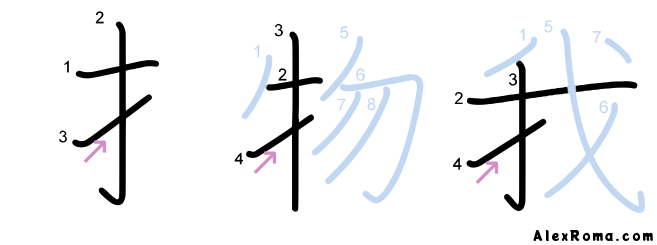Stroke direction rule 4 – the tehen rule
The 扌 tehen shape is the pictogram of a human hand, and it is the simplified form of the character 手 te ‘hand’. The tehen rule says:
The third stroke in the 扌 tehen shape is written from the bottom to the top.
In the diagram below the leftmost character is 扌 tehen. The red arrow shows the tehen rule, as the third stroke is written with an ascending motion.
The tehen rule also applies to similar shapes. The two other characters in the diagram are:
- 物 mono, where the shape 牜 ushihen ‘cow’ follows the tehen rule. In this case, the bottom-to-top stroke is the 4th stroke.
- 我 ware, containing an inconspicuous tehen shape within the whole shape of the character. Also in this character the bottom-to-top stroke is the 4th stroke.

It is important to pay attention to the following.
NB: do not mistake the 扌 tehen shape for the kanji 才 SAI, which is an entirely different shape and character.
The direction of the diagonal stroke in 才 SAI (3rd stroke) follows the normal top-to-bottom rule!

A great number of characters include the 扌 tehen shape, as pictograms of hands plays an important role in forming the meaning of many kanji. Some examples are:
- 打 utsu ‘to hit’,
- 払 harau ‘to sweep’,
- 扱 atsukau ‘to handle’,
- 折 oru ‘to snap off’,
- 招 maneku ‘to invite’,
- 掴 tsukamu ‘to grasp’,
and dozens more.
